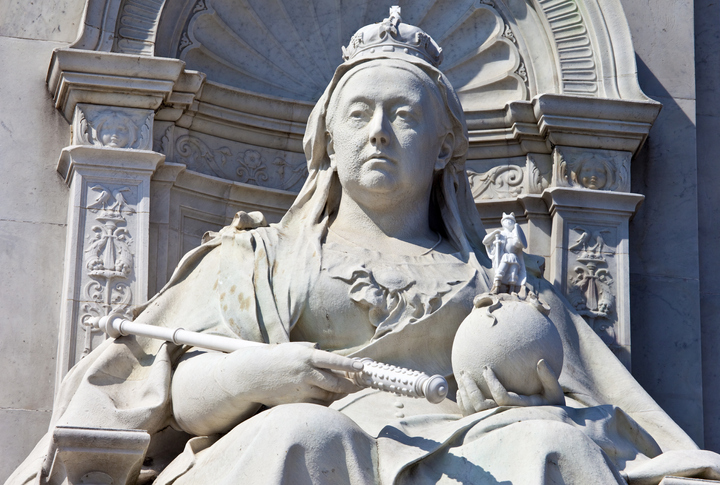Queen Victoria and Prince Albert's Bicentenary
In 2019 we celebrate the 200th anniversary of the births of Queen Victoria, the second-longest reigning monarch in British history, and her consort, Prince Albert. A season of special events have been scheduled, including displays at the Victoria and Albert Museum and Buckingham Palace, as part of the celebrations for this remarkable couple.
An unlikely queen
Victoria was just 18 when she became queen, although she had only been fifth in line to the throne when she was born at Kensington Palace on 24 May 1819. A report of her baptism was detailed in The London Gazette of 26 June (Gazette issue 17489).
Victoria was the only daughter of Prince Edward, the Duke of Kent, and Princess Victoire, of Saxe-Coburg-Saalfeld and the widow of the Prince of Leiningen. Her father had died shortly after her birth and she became heir to the throne because her three royal uncles, who were ahead of her in the line of succession, had no legitimate surviving children.
Prince Albert
Albert, the Prince Consort, was born on 26 August 1819, at Schloss Rosenau in Bavaria, the younger son of Ernest I, Duke of Saxe-Coburg-Gotha. In 1840, Victoria married Prince Albert, who was also her cousin, in a ceremony in the Chapel Royal of St James’s Palace (Gazette issue 19824).
The Great Exhibition at the Crystal Palace
Prince Albert was a man of wide intellectual interests, who took an active role in the arts, sciences, trade and industry. On 1 May 1851, the Queen opened the Great Exhibition, (Gazette issue 21208), accompanied by Prince Albert. The energetic patronage of the Prince Consort had done much to facilitate the event, and the exhibition was hailed as a great success, which encouraged a trend for international trade fairs. More details about the Crystal Palace Exhibition can be found in this article by Christopher Marsden, senior archivist at the Victoria and & Albert Museum.
The death of the Prince Consort
Albert’s premature death from typhoid fever in 1861, at the age of just 42, left Victoria in a state of deep mourning. Prince Albert’s funeral took place in St George’s Chapel, Windsor, while his final resting place, in the mausoleum at Frogmore, was being completed (Gazette issue 22584). It was not until the 1870s that Victoria was coaxed out of mourning and back into public life as the popular ‘Queen of the Jubilees’ by her prime minister, Benjamin Disraeli.
The Grandmother of Europe
As mother to nine children and grandmother to 42, some of whom were married into the
various European monarchies, Victoria ensured that the British Royal Family helped
to extend Britain’s influence and to build international allegiances (Gazette issue 25773) throughout Europe, perhaps most notably with the German and Russian royal dynasties.
Her eldest daughter, Victoria, the Princess Royal, ultimately became Empress of Germany
and Queen of Prussia, and mother to the last German Kaiser, Wilhelm II, with her marriage
to Prince Frederick William of Prussia, later Frederick III.  Tsar Nicholas II of Russia (pictured, with his son, the Tsarevich, Alexei) married
Queen Victoria’s granddaughter, who became the Empress Alexandra Feodorovna.
Tsar Nicholas II of Russia (pictured, with his son, the Tsarevich, Alexei) married
Queen Victoria’s granddaughter, who became the Empress Alexandra Feodorovna.
The Victoria Cross and the Crimean War
The Victoria Cross (VC) was established in January 1856, to recognise valour in the Crimean War (Gazette issue 21971). The VC is the highest military decoration, which is awarded for valour and devotion to duty in the face of the enemy, to the armed forces, regardless of rank. Before its creation, there was ‘no means of adequately rewarding the individual gallant services ... of officers of the lower grades in Our Naval and Military Service’ (Gazette issue 21846). The Gazette detailed many of the events of the Crimean War, (Gazette issue 100497) including despatches from the front, and the awards and promotions that followed.
Royal Births
It was Queen Victoria who made the decision to end the age-old practice of multiple witnesses attending royal births. The Home Secretary, Herbert Asquith, was the sole witness for the purposes of verification at the birth of the future Edward VIII in 1894 (Gazette issue 26525). Prior to this, numerous observers, in the form of privy councillors, ministers, ladies-in-waiting and medical advisors, would be present to attest to the new-born child being a true descendent of the monarch.
Queen Victoria’s death and the Victoria Memorial
Victoria’s death, aged 81, whilst at Osborne House on the Isle of Wight, and in the sixty-fourth year of her reign, was recorded in The Gazette (Gazette issue 27270) of 23rd January 1901, where the succession of her eldest son, Edward VII, was also proclaimed.
On 16 May 1911, some ten years after her death, and indeed a year after her son Edward VII had met his own end, a memorial statue was unveiled by her grandson, King George V (Gazette issue 28495) outside Buckingham Palace.
See also
You may also like
Victoria and Albert’s Museum – A season of special events is taking place at the V&A throughout 2019 as part of the celebrations for the bicentenary. #VictoriaAlbert200
Queen Victoria's Palace - A special exhibition telling the story of how the young queen transformed a private house into the working royal residence that we know today as Buckingham Palace. #BuckinghamPalace #RoyalCollection
Images:
The Opening of the Great Exhibition by Queen Victoria on 1 May 1851, oil painting, Henry Courtney Selous - © Victoria and Albert Museum, London
The Victoria Memorial, Buckingham Palace: Getty Images
